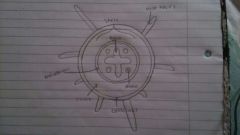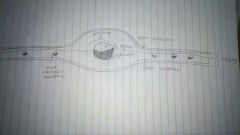![]()
![]()
![]()
Use LEFT and RIGHT arrow keys to navigate between flashcards;
Use UP and DOWN arrow keys to flip the card;
H to show hint;
A reads text to speech;
34 Cards in this Set
- Front
- Back
|
How can water and ions be moves through a plant? |
Epidermis, endodermis, xylem and phloem. |
|
|
How is water taken into the roots? |
Osmosis. |
|
|
How are ions taken into the roots? |
Active transport. |
|
|
How does water move through the apoplast pathway? |
Along the cellulose fibrils of the cell walls. |
|
|
How does water move through the symplast pathway ? |
Diffusing through cell cytoplasm to cell cytoplasm in the protoplast. |
|
|
Which pathway is quicker and why? Why may the slower one be used? |
The apoplast pathway is quicker aa there is least resistance but the symplast pathway is used, especially when there is a casparian strip present. |
|
|
What is a casparian strip? |
A band of suberin found in the endordermis which is impermeable to water and therefore acts as a barrier to the apoplast pathway. |
|
|
How does the endordermis ensure that water travels from the symplast pathway to the leaf? |
Due to the presence of a casparian strip, this allows active control and so water and ions can only move through the symplast pathway. Ions are forced/pumped into the xylem by the cytoplasm of the endodermal cells. Water follows along a resultant water potential gradient, thus creating root pressure, into the xylem, and also by a transpirational pull. |
|
|
Define transpiration. |
The process by which water moves out of a leaf by evaporation through the mesophyll surface and it's diffusion through the stomata. |
|
|
Explain cuticular transpiration. |
Although it acts as an efficient barrier, it is not completely impermeable to water and so cuticular transpiration is still possible. |
|
|
Explain stomatal transpiration. |
This is how water is usually lost. When the stomata open during the day to enable carbon dioxide to diffuse in, water vapour can also diffuse out ie stomatal transpiration. |
|
|
What internal factors affect the rate of transpiration? |
Thickness of cuticle - the thicker the cuticle, the more efficient the water barrier and therefore less water can diffuse out. Stomatal density - the more dense the stomata, the easier water can diffuse out due to the larger area. Leaf surface area - the larger the surface area, the more space available for the evaporation of water through the mesophyll surface and therefore the more transpiration can take place. |
|
|
What external factors affect the rate of transpiration? |
Light intensity - the stomata open when it is light only. Temperate - increases the amount of water able to evaporate from the mesophyll surface. Humidity - decreases transpiration as there is more water vapour outside the leaf and so water is less likely to diffuse out of the leaf. Air movement - can blow of the water vapour particles outside the leaf resulting in more water diffusing out of the leaf. Soil water availability - stomata can close in times of water shortage, therefore decreasing stomatal transpirational loss. |
|
|
How are vascular tissues structured in the root? |

|
|
|
How are vascular tissues structured in the stem? |

|
|
|
Explain the cohesion-tension theory, including the cohesive forces of water. |
To enable to water column to move as one, cohesive forces need to be present in order to prevent cavition/gaps in the water column to ensure that the tensions continue. |
|
|
Explain the adhesive forces of water. |
Adhesive forces enable the water column to stick to the walls of the cells to prevent it from falling down against the negative tensions. |
|
|
Explain the function of the xylem. |
To transport water and ions. |
|
|
Explain the function of lignin. |
To prevent the xylem from collapsing when under negative pressure, and it also provides support. |
|
|
What lignin patterns may be produced in the protoxylem? |
In the first formed xylem (protoxylem), annular or spiral patterns are produced in the growing regions behind the root and shoot tips, these allow the vessels to elongate with other tissues in the growing regions. |
|
|
What lignin patterns can be produced in the metaxylem? |
In the xylem produced in mature parts of plants (metaxylem), the greater deposition of lignin results in reticulated or pitted patterns. Reticulated patterns are thickened by interconnecting bars of lignin. Pitted patterns are uniformly thickened except at pores which are seen as pits which allow the movement of water and ions out of the vessels and into the cell. |
|
|
Why is movement through the xylem easier than movement through living cells? |
End walls break down as vessels form, and so a continuous tube is formed, therefore water movement through the xylem vessels requires less pressure than movement through living cells, where they would be slowed down by cell contents. |
|
|
Explain translocation. |
The movement of organic solutes within the phloem sap. |
|
|
Explain the movement through the phloem. |
It involves energy expenditure and a two way flow. |
|
|
What is the name and arrangement of the transporting cells? |
Sieve-tube elements - these lie end-to-end and form a continuous stack. |
|
|
What are sieve-plates? |
The thin cellulose walls at the end of the cells are perforated to form sieve-plates. |
|
|
Explain the structure and function of companion cells. |
Companion cells are closely related to the sieve-tube elements. The cytoplasm of the companion cells are linked via plasmodesmata, with that of the sieve-tube elements. Smaller companion cells have a denser cytoplasm, a large number of mitochondria and high levels of metabolic activity. This is important as sieve-tube elements lose their nuclei and many organelles as they mature. |
|
|
What does a phloem sap contain? |
The phloem sap contains mainly sucrose, but amino acids and other solutes are usually present. |
|
|
Provide evidence for the involvement of energy expenditure. |
The rate of flow is much higher than can be accounted for by diffusion. The companion cells have a particularly high density of mitochondria and metabolic activity is much higher than in other plant cells. ATP is used to pump solutes into the companion cells from where they enter the sieve-tube elements, via the plasmodesmata. |
|
|
Outline how movement of organic solutes in a plant occurs. |
Movement is two way, ie source to sink. The source is where sucrose is produced by photosynthesis or broken down by starch. The sink is the organ consuming/storing the carbohydrate. Sugars can be moved up into the developing buds, or down to the roots. Evidence for this comes from the radioactivity labelled sucrose. Following the supple of labelled sucrose in a mature plant, radioactivity is detected in the shoot tip above, and the roots below. |
|
|
What is a xerophytic leaf? |
A leaf adapted to dry conditions. |
|
|
What is a hydrophytic leaf? |
A leaf adapted to living in water. |
|
|
How are xerophytic leaves adapted to live in particular conditions? |
Small leaf surface area. Thick waxy cuticle. Multiple epidermal layers. Curled to maintain humidity outside the stomata. Hairs on lower surface to reduce airflow around stomata. Stomata may be sunken to reduce air flow. Leaves may be succulent to store water. Stomata may close during the day and open at night. |
|
|
How are hydrophytic leaves adapted to live in particular conditions? |
Little or no waxy cuticle as there is no need to limit water exit. Stomata on upper surface to facilitate entrance of gases. Large air spaces facilitate gaseous exchange and aids buoyancy. Xylem is poorly developed as water transport is not a problem. |

